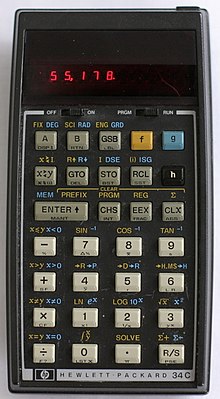HP-34C
The HP-34C was the top model of the so-called "thirties" line of pocket calculators from Hewlett-Packard . It was produced from 1979 to 1983 and, in addition to being fully equipped with mathematical and scientific functions, was the first pocket calculator to have a numerical zero point search and numerical integration . The application manual of the HP-34 contained detailed explanations of the complex functions as well as various program examples and also included two games.
Functions
The zero point search solved problems of the kind . The function to be solved was defined as a subroutine - possibly after corresponding transformations - and had to leave the function value in the display register (X register). The call was made by entering two start values and the function followed by the label of the subroutine. Further solutions could possibly be found through new starting values. The algorithm was programmed robustly, and the manual provided comprehensive information on the mathematical background and possible problems with "exotic" functions.
SOLVE (f .)
The even more complex integration worked in a similar way. The choice of the display format allowed an accuracy to be specified; the again very robust algorithm also provided an - almost always very conservative - estimate for the error of the integral. At 32 pages, the manual section for this complex function was even more detailed than that of the root search. This calculation could easily take several minutes.
The memory had been significantly expanded and consisted of 7168 (7 Ki) words of 10 bit ROM each and a RAM of 64 registers of 7 bytes each. The user could use 70 program lines and 21 data registers (corresponding to 31 registers) when the device was switched on for the first time, including an index register I, which allowed indexed addressing. For longer programs, data registers were automatically converted into 7 program lines each, so that a maximum of 210 program lines were possible. The index register I was then left as the only data register; the remaining registers were used for internal functions and were not accessible to the user. All memory contents were retained when switching off and changing the battery. The programming includes conditional branches, subroutines with up to 6 levels, extended comparisons (8 different possible) and stack manipulation, flags and two keys "A" and "B" that can be used as short-form labels (i.e. the programs with LBL Aand LBL Bcan be executed with just one keystroke ). In this model, the keys were four-fold, with a fourth function printed on the inclined front, as was the case with the HP-67 , but the second / third function was printed behind the keys.
The program lines each took up a complete command, which could consist of up to three keystrokes (“fully merged keystrokes”). Internally, each such command occupied one byte. Since only 256 different codes are possible with this, some commands were restricted as follows:
- SOLVE and INTEGRATE can only be programmed with labels 0-3, A or B.
- Memory arithmetic is only possible with memories 0-9 and (i), not with I or memories from .0
- there are only 12 labels (0-9, A and B) available
- there are only four flags, 0-3.
comparison
In its time, the HP-34C was in competition with the TI-58 (C) and TI-59 models , which were significantly cheaper and also calculated faster, but did not match the quality of the HP. This applies to mechanical production (especially the keys), but also to numerical robustness. During this time, the question of whether UPN or AOS was the better input logic was discussed intensively.
Internally, the HP-34C had to assert itself against the HP-41C and its professional claim, which in addition to its usability (significantly longer runtimes thanks to the energy-saving LCD instead of LED display) was particularly evident in the flexibility of programming, alphanumerics and expandability, and only was offset by the even higher price. The HP-67 , which belonged to the previous generation , but was partly more powerful , was also sold in parallel with the HP-34C, also at a significantly higher price. Overall, the HP-34C was able to maintain its position well up to the appearance of the HP-15C .
See also
- Development history of the programmable pocket calculator
Web links
- HP 34C - Museum of HP Calculators
- Hewlett-Packard HP-34C. rskey.org
- HP Calculator internals (English)

